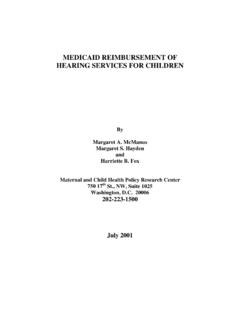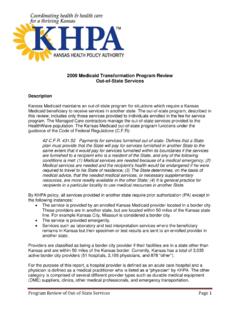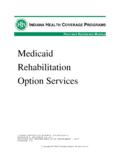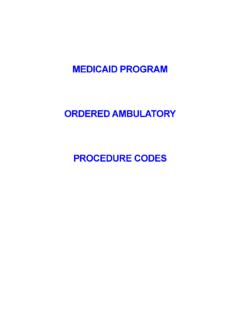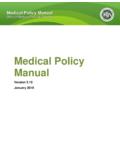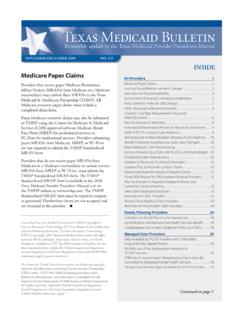Transcription of MEDICAID REIMBURSEMENT OF HEARING …
1 MEDICAID REIMBURSEMENT OF. HEARING services FOR CHILDREN. By Margaret A. McManus Margaret S. Hayden and Harriette B. Fox Maternal and Child Health Policy Research Center 750 17th St., NW, Suite 1025. Washington, 20006. 202-223-1500. July 2001. Acknowledgments This study was funded by the federal Maternal and Child Health Bureau (MCHB). through the National Center for HEARING Assessment and Management (NCHAM). Karl White, director of NCHAM; Terry Foust, Region VIII coordinator of the Early HEARING Detection and Intervention technical assistance network; and Hallie Morrow, Public Health Medical Officer at the Children's Medical services Branch of the California Department of Health services , provided invaluable expert assistance. We also gratefully acknowledge Mary Reichman of the MCH Policy Research Center for her research assistance and both Bonnie Strickland and Irene Forsman of the MCHB for their support and guidance. TABLE OF CONTENTS. I. Introduction and Methods.
2 1. II. REIMBURSEMENT Findings ..4. A. Audiologic Diagnostic Evaluation and Treatment services ..4. B. Audiologic Function C. HEARING Aid services ..5. D. Cochlear Implant services ..7. E. Assistive Communication F. Changes in MEDICAID REIMBURSEMENT Policies Pertaining to Newborn HEARING III. Tables Table I: State MEDICAID Payment Arrangements, 1999. Table II: State MEDICAID Fee-for-Service REIMBURSEMENT Policies for HEARING Detection and Intervention services , 2000. Table III: State MEDICAID Fee-for-Service Payment Amounts for HEARING Detection and Intervention services , 2000. MEDICAID REIMBURSEMENT OF. HEARING services FOR CHILDREN. I. Introduction and Methods State MEDICAID agencies pay for HEARING services either as part of a monthly capitated payment to a managed care organization (MCO), or as a fee-for-service (FFS). payment to a provider directly. Direct provider payments are made under three types of arrangements: when a child is not enrolled in any type of managed care and the state MEDICAID agency reimburses all MEDICAID services ; when a child is enrolled in a primary care case management system (PCCM) and the state MEDICAID agency reimburses all or most MEDICAID services ; or when a child is enrolled in an MCO and HEARING services are carved out of the managed care contract.
3 In 1999, 20% of all children were insured by Although state MEDICAID agencies vary widely in their use of MCOs, the bulk of children are enrolled in fully capitated MCOs. Of the 44 state MEDICAID agencies that responded to our survey, 38. (86%) enrolled some or all eligible children into MCOs on a limited or statewide basis in 1999, 2 as shown in Table I. Five of the 38 states relied exclusively on MCOs. Twenty- seven of the 44 states in our survey (61%) enrolled some or all eligible children into PCCMs on a limited or statewide basis in 1999, and 38 states (86%) retained FFS. arrangements, but mostly on a limited basis. Only six states relied exclusively on PCCMs or FFS arrangements in 1999. State MEDICAID agencies establish their fees according to CPT,3 HCPCS,4 or state- specific codes. Just over half of the states in our survey used CPT or HCPCS codes 1. American Academy of Pediatrics. Children's Health Insurance Status and Public Program Participation. Elk Grove Village, Il: American Academy of Pediatrics, 2000.
4 2. Fox HB, Austrian JS, Hsu W and Limb S. An Analysis of states ' MEDICAID Managed Care Enrollment Policies Affecting Children, 1996-1999. Washington, DC: Maternal and Child Health Policy Research Center, October 2000. 3. American Medical Association. Physicians' Current Procedural Terminology, Standard Edition. Chicago, IL: American Medical Association, 2000. exclusively, the remaining states used state-specific codes, but usually for only a handful of services , including HEARING aid services . About 40% of states use different rate structures for specific HEARING services , depending on whether they are furnished in an inpatient hospital setting, outpatient hospital setting, or clinic setting. The Maternal and Child Health Policy Research Center, with funding from the federal Maternal and Child Health Bureau through the National Center for HEARING Assessment and Management at Utah State University, was asked to examine variation in state MEDICAID payment methods and amounts for a comprehensive set of HEARING services for children enrolled in MCOs, PCCMs, and FFS arrangements.
5 In a previous report, we analyzed MEDICAID managed care contract specifications for HEARING services under the Early and Periodic Screening, Diagnosis and Treatment (EPSDT) This study addresses four research questions. First, what HEARING service codes do states consider allowable for REIMBURSEMENT purposes? Second, what are the average and range of MEDICAID payment amounts for specific HEARING services reimbursed on a fee- for-service basis? Third, what HEARING services are most likely to be carved out of MCO. contracts and paid for on a fee-for-service basis? Fourth, what recent MEDICAID REIMBURSEMENT changes have been made pertaining to newborn HEARING screening and follow-up tests? The MCH Policy Research Center obtained state MEDICAID REIMBURSEMENT information for 2000 based on a mail survey questionnaire conducted between November 2000 and February 2001. A comprehensive list of HEARING services was identified by Karl White of the National Center for HEARING Assessment and Management and Terry Foust of Intermountain Health Care Community Clinics.
6 In each state, we contacted the EPSDT director to identify the MEDICAID staff person responsible for REIMBURSEMENT policy or HEARING services . Once identified, the survey was faxed or mailed to that individual. Forty-four states responded to our survey, giving us an 84% response rate. We asked states to provide us with REIMBURSEMENT information for a comprehensive list 4. Health Care Financing Administration. Alpha-Numeric HCFA Common Procedure Coding System. Washington, DC: Government Printing Office, 2000. 5. McManus M, Hayden M, and Fox H. MEDICAID Managed Care Contract Provisions Pertaining to Early HEARING Detection and Intervention services . Washington, DC: Maternal and Child Health Policy Research Center, January 2001. of 39 HEARING services . In a few instances states did not provide us with information for all of these services , and were excluded from the relevant service analysis. When state- specific codes were used, we translated these codes into comparable CPT or HCPCS.
7 Codes. When states paid different amounts depending on the setting, we collected the rates paid to clinics. Although the REIMBURSEMENT information we received from states is certainly accurate, the responses we received on HEARING services carved out of managed care contracts may be less reliable, particularly for services that may be financed separately under early intervention or health-related special education services , despite the fact that all states not reporting carve-outs for cochlear implants or assistive listening devices were called back for confirmation purposes. Study results on MEDICAID REIMBURSEMENT policies are presented according to diagnostic and treatment services , audiologic tests, HEARING aid services , and cochlear implant and other services . A review of average payment amounts and ranges follows. The report ends with a summary of state REIMBURSEMENT changes and issues related to newborn HEARING screening. II. REIMBURSEMENT Findings A. Audiologic Diagnostic Evaluation and Treatment services The two audiologic diagnostic evaluation and treatment services examined were special otorhinolaryngologic services not usually included in a comprehensive otorhinolaryngologic evaluation or office visit.
8 These are: 1) evaluation of speech, voice, communication, auditory processing, and aural rehabilitation status (CPT 92506) and 2). treatment of these disorders (92507). All but two state MEDICAID programs in our study sample (95%) allowed qualified providers to bill on a fee-for-service basis for an audiologic evaluation of speech, language, voice, communication, auditory processing, and aural rehabilitation status in 2000, as shown on Table II. A somewhat smaller proportion of states (86%) had a billable code for treatment of speech, voice, communication, and auditory processing disorders. Only one of the 36 states (California). that contracted with MCOs carved these two services out of their capitated rates and paid for them on a fee-for-service basis. Payment amounts for diagnostic evaluation were 50% higher than for treatment, as shown in Table III. For diagnostic evaluation, state MEDICAID agencies reimbursed, on average, $ , but fees ranged from a low of $ to a high of $ If the difference between highest and lowest amount -- $ -- were divided into thirds, we would find that 19% of states were paying in the lowest third, 53% were paying in the middle third, and 28% were paying in the highest third.
9 For treatment, state MEDICAID agencies reimbursed, on average, $ , with the lowest fee of $7 and the highest fee of $ Importantly, differences in MEDICAID payment rates for these two special audiologic services may be attributable in part to the length of the visit (15, 30, or 60. minutes), which was not taken into account in the CPT codes. Unfortunately, few states provided us with visit duration information. B. Audiologic Function Tests The 13 audiologic function tests with medical diagnostic evaluation that we analyzed use calibrated electronic equipment. Other HEARING tests (such as whispered voice, tuning fork) considered part of the general otorhinolaryngologic services were not reported separately. Our survey revealed that almost all states had billable codes for each of the 13 audiologic function tests, as shown on Table II. The few that did not lacked codes for visual response audiometry, select picture audiometry, and evoked otoacoustic emissions (limited).
10 Not unlike the findings described above for audiologic diagnostic evaluation and treatment, we found very few states allowed audiologic function tests to be carved out of their capitated managed care arrangements. The exceptions were California, for all 13 tests; Florida, for 10 tests; and Maryland, for four tests. Fees for audiologic function tests varied significantly by test, as shown in Table III, with payments for auditory evoked potentials reimbursed at the highest average rate ($ ) and acoustic reflex testing at the lowest average rate ($ ). Comprehensive HEARING evaluation fees, which typically include otoscopic inspection, puretone testing, tympanometry, and speech threshold as well as the professional time of an audiologist, were on average only $ , and ranged from a low of $19 to a high of $ The three audiologic function tests with the greatest variation in payment amounts were select picture audiometry, pure tone screening test (air only), and evoked otoacoustic emissions (limited).
